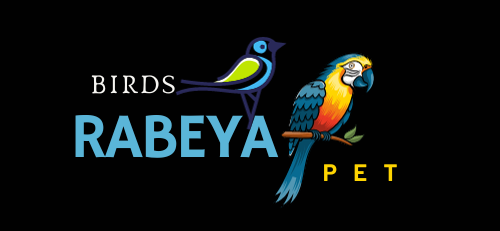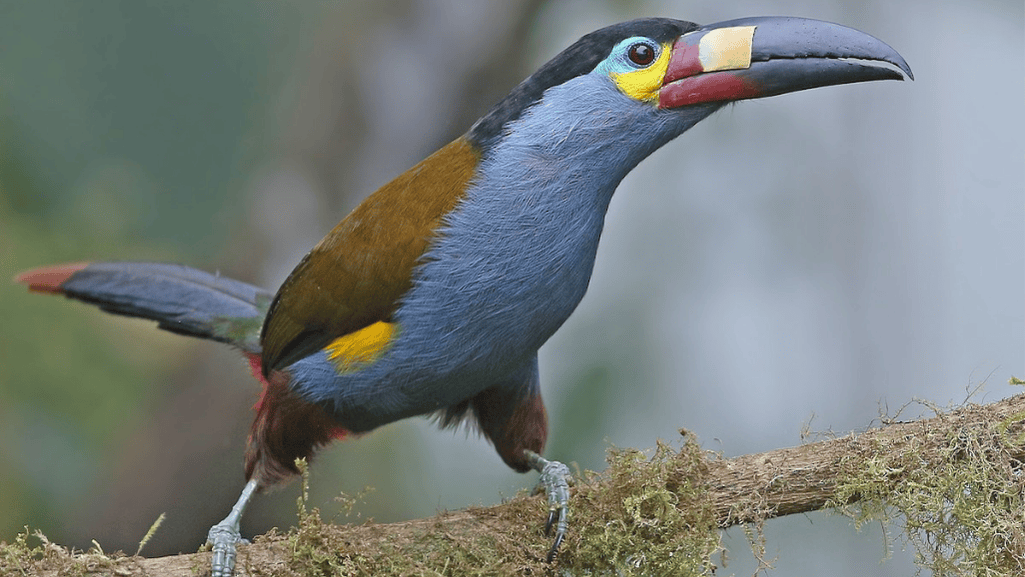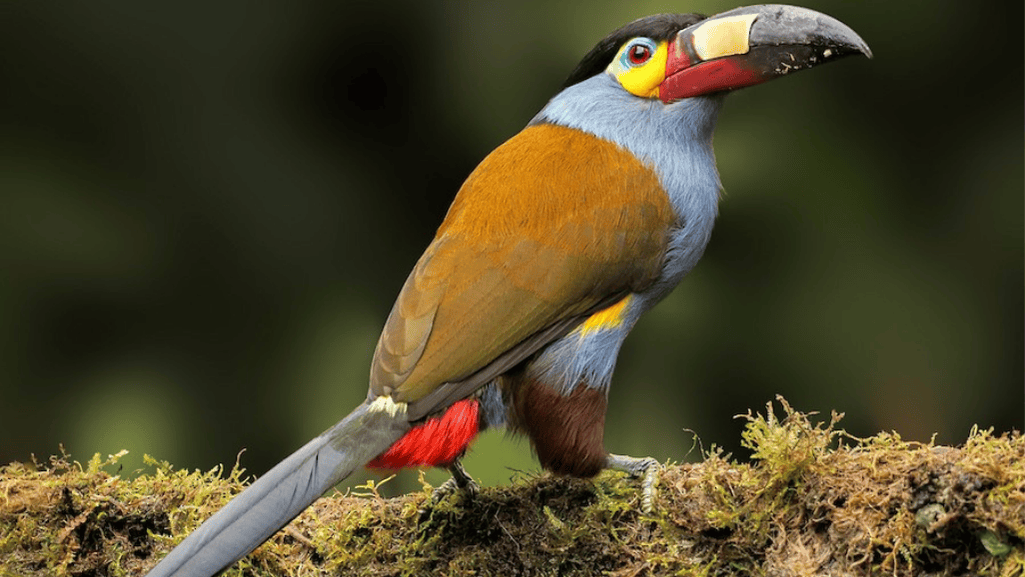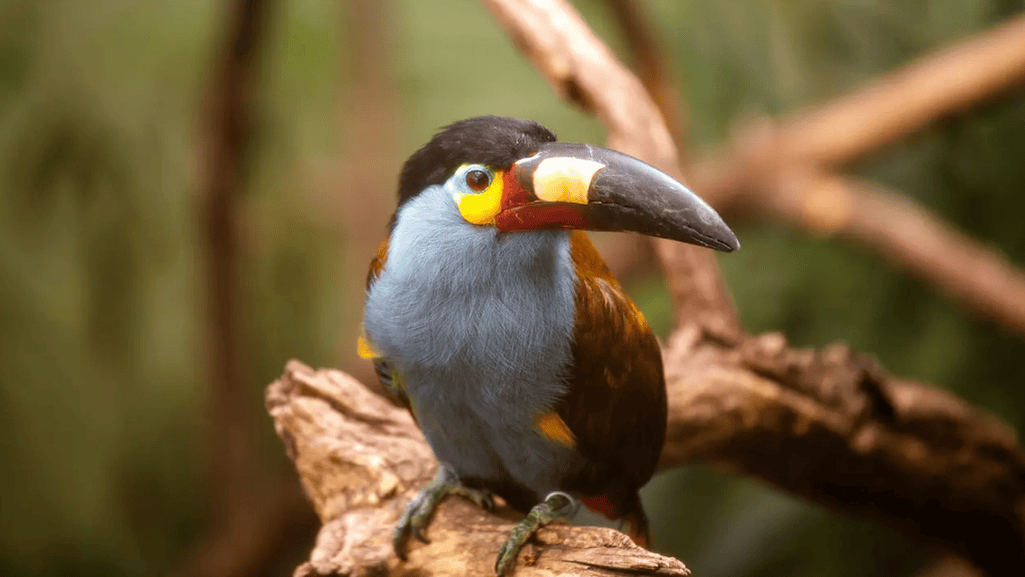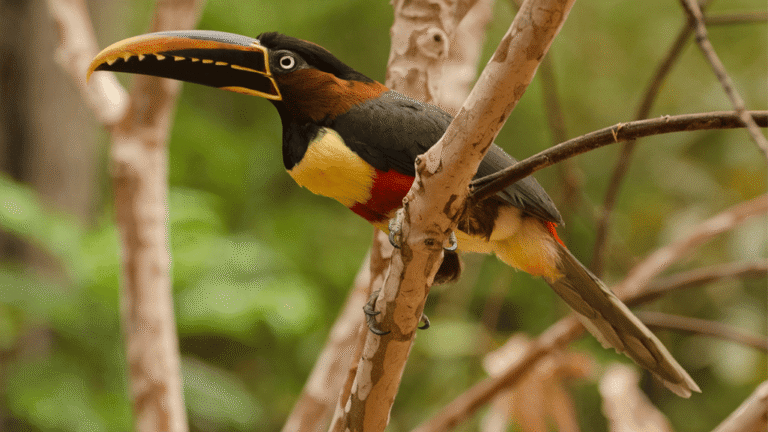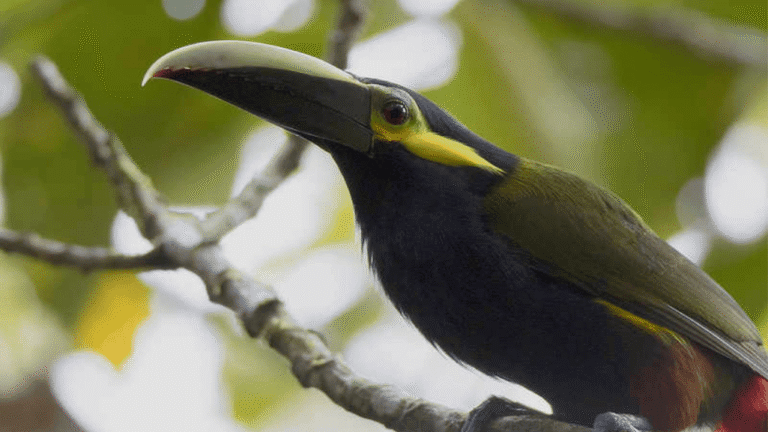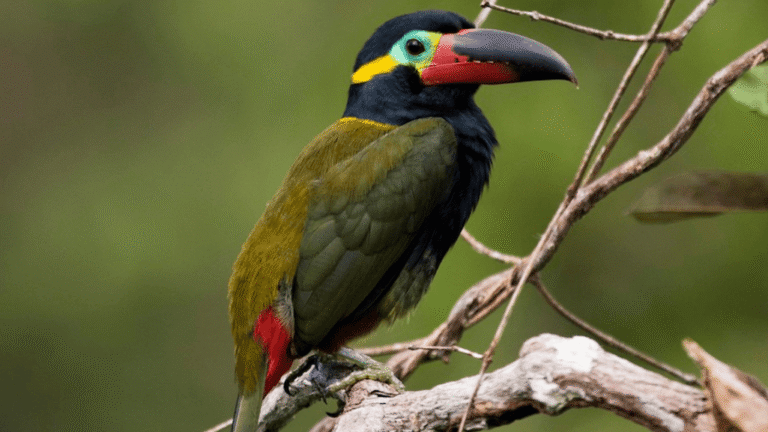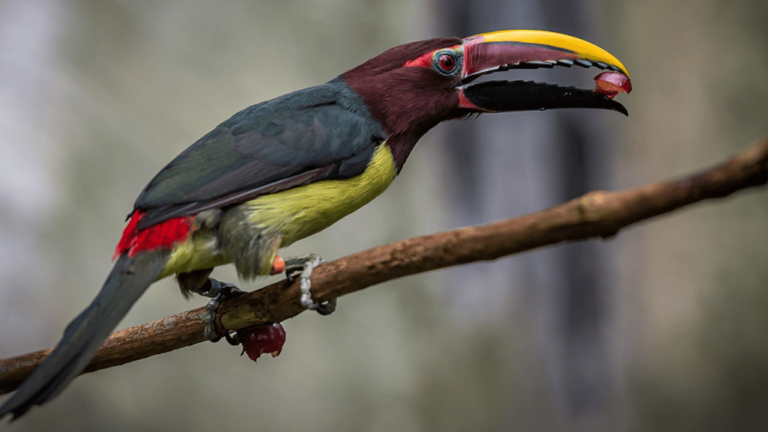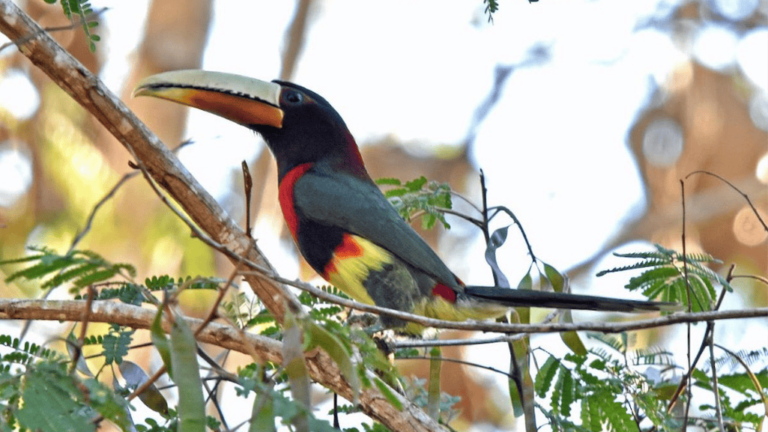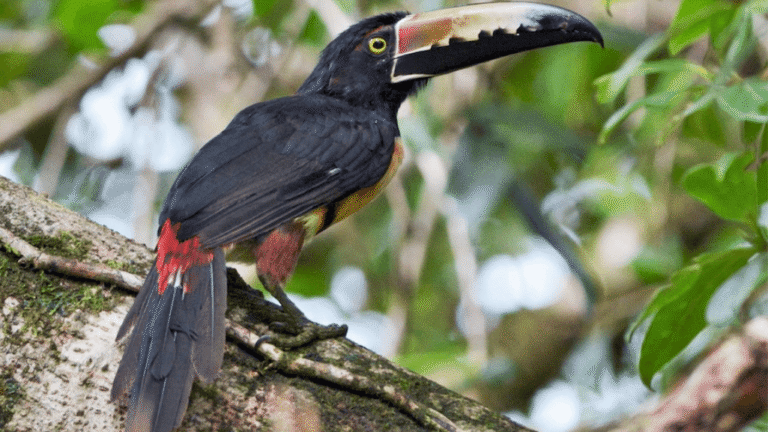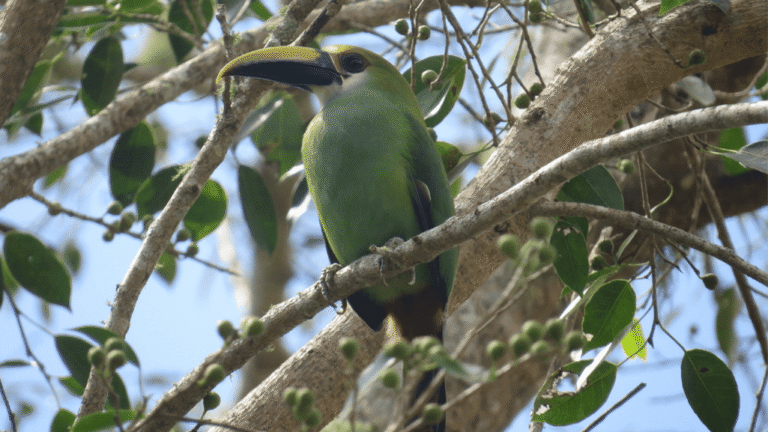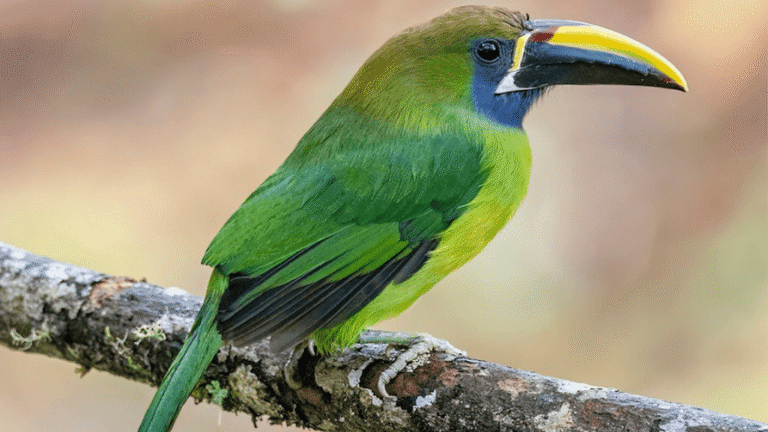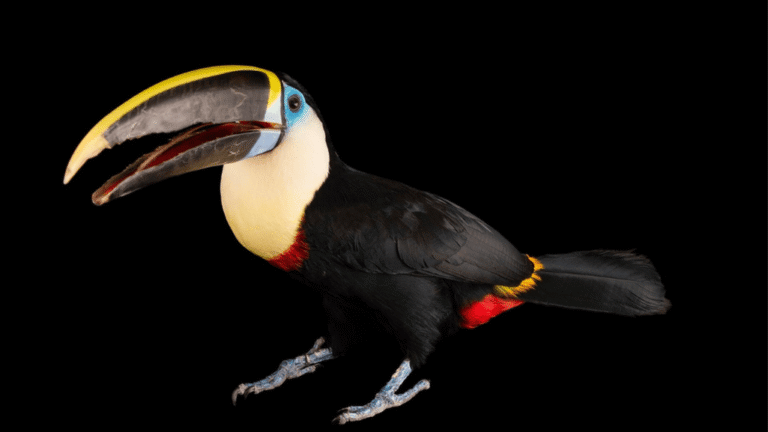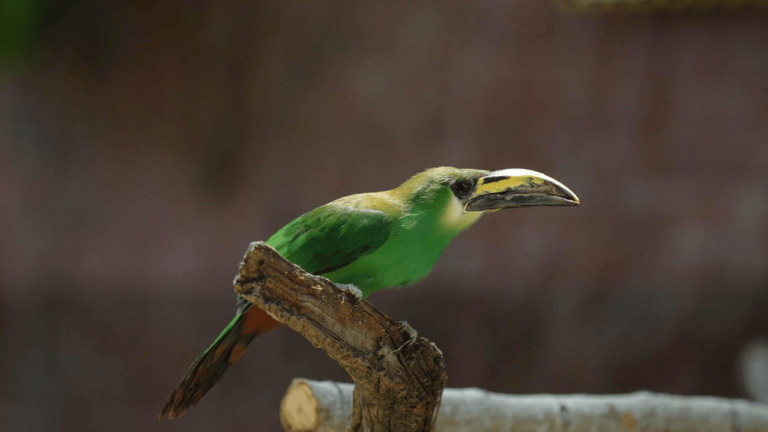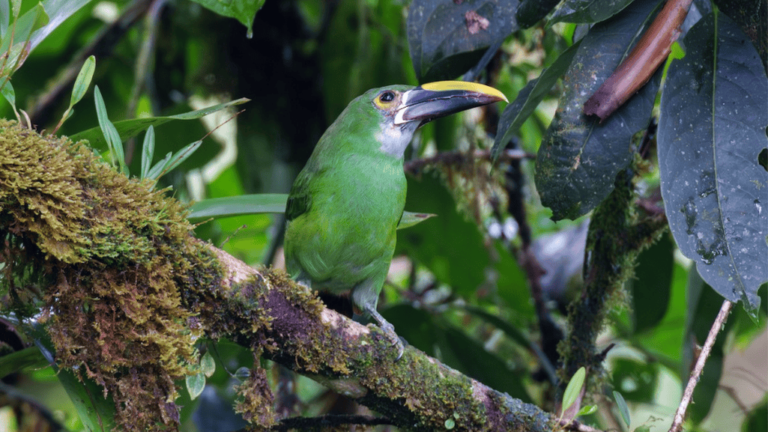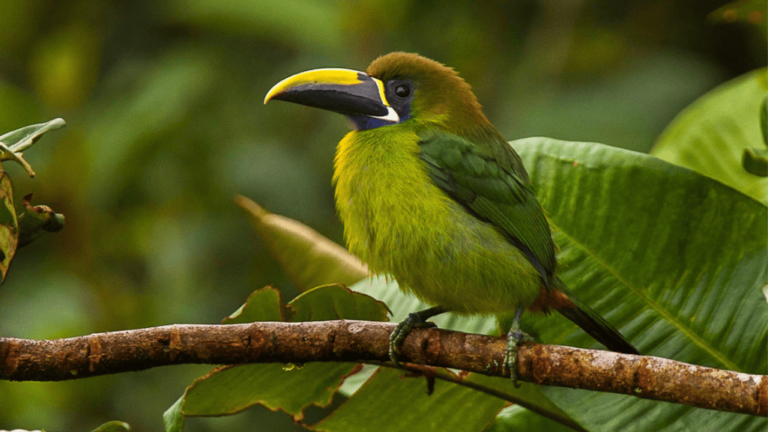Are you ready to delve into the fascinating world of bird species? One particular avian marvel that commands attention is the Plate-billed Mountain Toucan. Found in the Andean cloud forests of northwestern Ecuador and southwestern Colombia, this vibrant creature is a true emblem of the biodiversity hotspot it calls home.
The Plate-billed Mountain Toucan showcases a stunning combination of colors, with blue underparts, a coppery back, a black crown and nape, red undertail coverts, and, most notably, a yellow “plate” adorning its bill. Whether encountered in pairs or small groups, this mountain toucan astounds with its enchanting appearance and melodic song, characterized by a far-carrying metallic wail bookended by a bill rattle.
Prepare to be captivated by the allure of the Plate-billed Mountain Toucan, as we explore its description, habitat, behavior, and more.
Key Takeaways:
- The Plate-billed Mountain Toucan boasts a striking appearance, with colorful plumage and a unique bill featuring a yellow “plate.”
- Found in the Andean cloud forests of Ecuador and Colombia, this toucan thrives in a biodiverse hotspot.
- Plate-billed Mountain Toucans are known for their vocalizations, including a distinct song and various rattles and clicks.
- These toucans play a vital role in seed dispersal in their habitat, by feeding on fruit and insects.
- Conservation efforts are crucial to ensure the survival of this extraordinary bird species and preserve the biodiversity of its habitat.
Description and Measurement
The Plate-billed Mountain Toucan is known for its unique bill, vibrant coloration, and size. With its large laterally compressed bill, the front half is black, while the back half is mostly red with a raised yellow plate on the upper mandible. This distinct bill feature gives the bird its name, making it easily recognizable in its natural habitat.
The toucan’s plumage is a stunning combination of golden olive on the upperparts and wings, bright blue on the underparts, and black on the crown and neck. This vibrant coloration adds to its charm and beauty, making it a favorite among birdwatchers and wildlife enthusiasts.
Measuring about 16.5 to 21 inches (42 to 53 cm) in length, the Plate-billed Mountain Toucan is a relatively large bird. Males weigh around 11.1 ounces (315 g), while females weigh approximately 10.7 ounces (303 g). These majestic birds showcase their impressive size and striking appearance as they navigate through the branches of the Andean cloud forests.
| Characteristics | Measurements |
|---|---|
| Bill coloration | Black front half, red back half with raised yellow plate on upper mandible |
| Plumage coloration | Golden olive upperparts and wings, bright blue underparts, black crown and neck |
| Length | 16.5 to 21 inches (42 to 53 cm) |
| Male weight | Around 11.1 ounces (315 g) |
| Female weight | Approximately 10.7 ounces (303 g) |
Bill Structure
The Plate-billed Mountain Toucan’s bill is not only visually striking, but it also serves important functional purposes. Its large size and laterally compressed shape enable the bird to access a wide range of food sources, including fruits, insects, and occasional eggs. The bill’s raised yellow plate on the upper mandible is believed to play a role in displaying and attracting mates, as well as distinguishing territorial boundaries.
Coloration and Camouflage
The toucan’s coloration is not only aesthetically pleasing but also serves practical purposes. The combination of golden olive, bright blue, and black on different parts of its body helps the bird blend into its natural habitat, offering camouflage and protection from predators. This adaptation allows the Plate-billed Mountain Toucan to move through the dense foliage of the Andean cloud forests with ease and stealth.
Habitat and Range
The Plate-billed Mountain Toucan is best known for its presence in the high-altitude Andean cloud forests of northwestern Ecuador and southwestern Colombia. These unique habitats, also known as montane forests, are characterized by their high levels of humidity and stunning biodiversity. The toucan thrives in this environment, making the Andean cloud forests its home.
Spanning across the elevations of 1600 to 2600 meters above sea level, the Plate-billed Mountain Toucan shares its ecological niche with various other species, such as the Andean cock-of-the-rock. Within this altitudinal range, the toucans can be found perched on branches, hopping from tree to tree, and exploring the diverse flora and fauna of the ecosystem.
More specifically, the Plate-billed Mountain Toucan is found in the northwestern regions of Ecuador and extreme southern regions of Colombia. These areas are known for their rich biodiversity and are considered biodiversity hotspots due to their abundant epiphytes, bromeliads, and mosses.
The estimated natural range of the Plate-billed Mountain Toucan covers approximately 14,300 square kilometers. With their vibrant plumage and captivating presence, these toucans contribute to the beauty and ecological significance of the Andean cloud forests.
Habitat and Range Table
| Species | Habitat | Range |
|---|---|---|
| Plate-billed Mountain Toucan | Andean cloud forests | Northwestern Ecuador and extreme southern Colombia |
Behavior and Communication
Plate-billed Mountain Toucans are fascinating creatures with unique behaviors and vocalizations that set them apart from other mountain toucans. Let’s explore their roosting habits, foraging techniques, and the distinct vocalizations they use to communicate.
Roosting
Plate-billed Mountain Toucans are social birds that often roost in pairs, families, or small groups within their territorial range. Roosting is an essential part of their daily routine, providing them with protection and a safe place to rest.
Foraging
The main food source for Plate-billed Mountain Toucans is fruit-rich trees found in their habitat. They employ a cooperative foraging technique, where they gather together to feed on fruits. In addition to fruits, they also eat insects and eggs on occasion, supplementing their diet with protein-rich prey.
By foraging together, these toucans not only increase their chances of finding abundant food but also strengthen social bonds within their group.
Vocalizations
Plate-billed Mountain Toucans are known for their vibrant vocalizations, which serve multiple purposes in their social interactions and communication within the group.
Males produce a distinctive loud repeating “tryyyyyyyk” sound, which is often heard echoing through the cloud forests. This vocalization is used for various reasons, including territorial defense, attracting mates, and signaling their presence to other toucans in the vicinity.
Females, on the other hand, make a drier “t’t’t’t’t’t” noise, which has a different tone and serves as their vocalization in response to males or during specific social interactions.
Aside from these vocalizations, Plate-billed Mountain Toucans also utilize rattles and clicks, which can be heard from over a kilometer away. These additional vocalizations add complexity to their communication repertoire and facilitate interactions among individuals in the group.
Observing and documenting the varied vocalizations of Plate-billed Mountain Toucans allows researchers to delve deeper into their behavior and gain a better understanding of their social dynamics within their habitat.
The unique vocalizations displayed by these toucans highlight their significance in the ecosystem and contribute to the overall auditory richness of the cloud forests they call home.
| Vocalization Type | Description |
|---|---|
| Males | Loud repeating “tryyyyyyyk” sound |
| Females | Drier “t’t’t’t’t’t” noise |
| Rattles and Clicks | Audible from over a kilometer away |
Reproduction and Breeding
Plate-billed Mountain Toucans are monogamous and breed from March to October, with a peak in May through August. They build their nest in tree cavities, usually in abandoned woodpecker nests, located up to 30 meters above the ground.
Each clutch consists of 2 or 3 white eggs, which are incubated by both parents for approximately 16 days. Once the eggs hatch, the parents nurture and care for the young until they are ready to fledge.
- Monogamous breeding from March to October
- Build nests in tree cavities, up to 30 meters high
- Clutches contain 2 or 3 white eggs
- Eggs incubated by both parents for about 16 days
- Youthful toucans fledge after 46 to 60 days
After fledging, which occurs between 46 to 60 days, the young toucans leave the nest. However, the pair may rear a second brood after the departure of the first brood.
Reproduction and Breeding Key Points:
- Monogamous breeding behavior observed
- Nests built in abandoned tree cavities
- Each clutch contains 2 or 3 white eggs
- Both parents incubate the eggs for about 16 days
- Young toucans fledge after 46 to 60 days
- Possible second brood rearing by the breeding pair
Diet and Feeding Habits
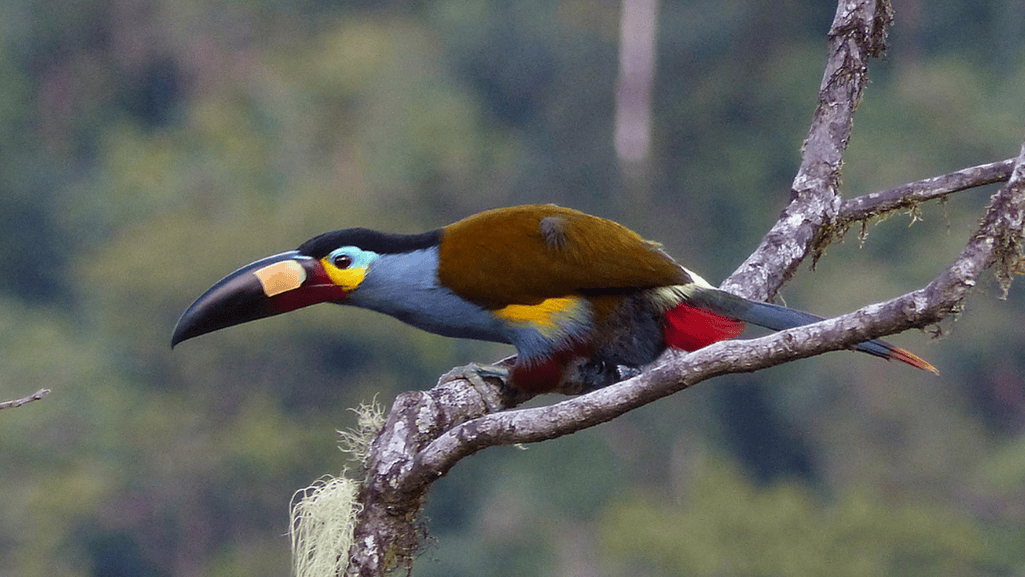 The Plate-billed Mountain Toucan is known for its diverse diet, which primarily consists of fruit. This toucan is a true fruit-lover, feeding on a variety of fruits found in its habitat. In addition to fruit, the toucan also consumes insects and eggs on occasion, making its diet quite versatile. By incorporating a range of food sources into its diet, the Plate-billed Mountain Toucan ensures that it receives a balanced and nutritious intake.
The Plate-billed Mountain Toucan is known for its diverse diet, which primarily consists of fruit. This toucan is a true fruit-lover, feeding on a variety of fruits found in its habitat. In addition to fruit, the toucan also consumes insects and eggs on occasion, making its diet quite versatile. By incorporating a range of food sources into its diet, the Plate-billed Mountain Toucan ensures that it receives a balanced and nutritious intake.
However, the feeding habits of the Plate-billed Mountain Toucan extend beyond simply satisfying its own hunger. This remarkable bird plays a crucial role in seed dispersal within its ecosystem. As it feeds on fruits, the toucan inadvertently picks up the seeds of various plants on its bill and subsequently disperses them as it moves between trees. This process aids in the distribution of seeds and promotes the growth and survival of different plant species.
Two notable examples of plants whose seeds are dispersed by the Plate-billed Mountain Toucan are the mountain understory shrub, Faramea affinis, and the palm, Prestoea acuminata. These plants rely on the toucan’s feeding habits for their seeds to be transported to new locations, allowing them to colonize different areas and maintain genetic diversity.
Interestingly, there have even been instances where the Plate-billed Mountain Toucan has been observed feeding on unconventional prey. This includes instances of the toucan consuming a type of amphibian known as a caecilian. These observations highlight the toucan’s adaptability and its ability to exploit available food sources within its environment.
Diet Overview of the Plate-billed Mountain Toucan
| Food | Percentage of Diet |
|---|---|
| Fruit | 70% |
| Insects | 25% |
| Eggs | 5% |
Conservation Status and Conclusion
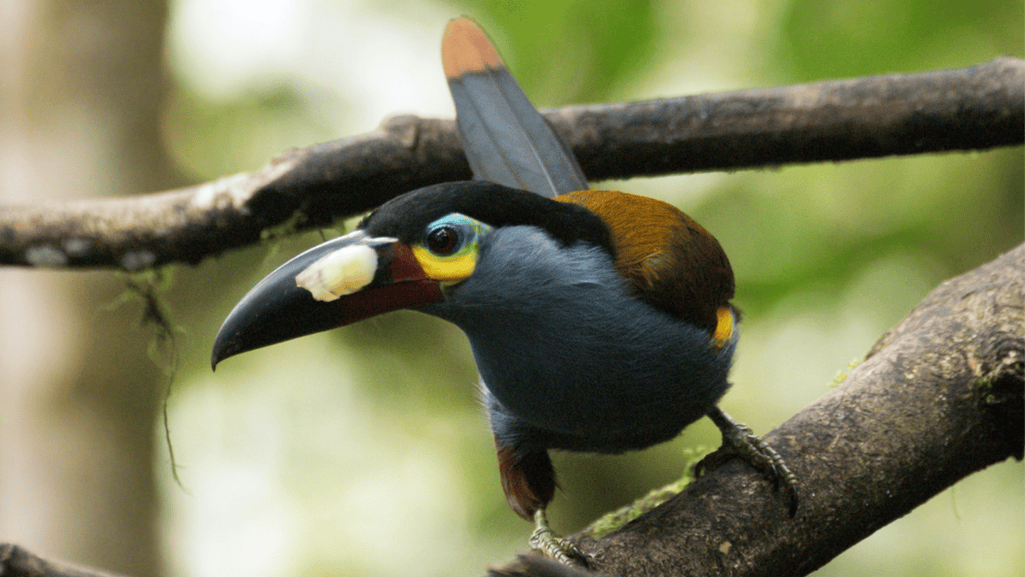 The Plate-billed Mountain Toucan, also known as Andigena laminirostris, is currently classified as Near Threatened on the IUCN Red List. This designation highlights the urgent need for conservation efforts to protect this stunning bird species from further decline.
The Plate-billed Mountain Toucan, also known as Andigena laminirostris, is currently classified as Near Threatened on the IUCN Red List. This designation highlights the urgent need for conservation efforts to protect this stunning bird species from further decline.
One of the main threats faced by the Plate-billed Mountain Toucan is habitat loss resulting from deforestation. The destruction of its natural forest habitat not only diminishes the toucan’s population but also negatively impacts the rich biodiversity of the surrounding ecosystem.
To safeguard the future of this magnificent bird, conservation initiatives focused on preserving its habitat are crucial. The La Planada Nature Reserve in Colombia is a shining example of a project dedicated to protecting the Plate-billed Mountain Toucan and its habitat. By supporting such efforts, we can contribute to the conservation of this species and the ecosystem it depends on.
Deforestation and illegal trade pose significant challenges, but with increased awareness and united action, we have the power to make a difference. Together, we can secure a brighter future for the Plate-billed Mountain Toucan, ensuring its survival for generations to come.
FAQ
Where can the Plate-billed Mountain Toucan be found?
The Plate-billed Mountain Toucan can be found in the Andean cloud forests of northwestern Ecuador and southwestern Colombia.
What are the distinguishing features of the Plate-billed Mountain Toucan?
The Plate-billed Mountain Toucan has a large laterally compressed bill with a yellow “plate” on the upper mandible. Its plumage is a combination of golden olive on the upperparts, bright blue on the underparts, and black on the crown and neck.
How does the Plate-billed Mountain Toucan communicate?
The Plate-billed Mountain Toucan is known for its vocalizations, which include a far-carrying metallic wail preceded by a bill rattle. Males produce a loud repeating “tryyyyyyyk” sound, while females make a drier “t’t’t’t’t’t” noise.
How does the Plate-billed Mountain Toucan contribute to seed dispersal?
The Plate-billed Mountain Toucan primarily feeds on fruit, playing a crucial role in seed dispersal. It helps disperse the seeds of plants such as the mountain understory shrub Faramea affinis and the palm Prestoea acuminata.
What is the conservation status of the Plate-billed Mountain Toucan?
The Plate-billed Mountain Toucan is classified as Near Threatened on the IUCN Red List. It faces threats primarily due to habitat loss caused by deforestation and illegal trade. Conservation efforts are essential to ensure its survival.

